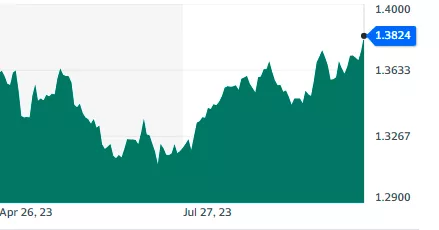 Photo by Michelle Spollen on Unsplash
Photo by Michelle Spollen on Unsplash
Canadians are starting to realize that the decline in the value of the Loonie signifies an economy that is in a recessionary phase. The Bank of Canada’s decision yesterday to hold its bank rate steady is as much a confirmation that the economy is weakening, as it is a confirmation that its policy is working to bring down the rate of inflation. Since July, the CDN Dollar has fallen by 5%, and as the US and Canadian economies diverge, we can expect a continuation in that decline. Let’s look at what lies behind the Loonie’s softening.
CDN Dollar/USD The Bank of Canada continues to misread the tea leaves, especially in its overconfidence regarding economic growth. When it embarked on its almost relentless drive to raise the bank rate about 18 months ago, it assumed that economic growth was not sustainable, leading to continued high rates of inflation. However, its forecasts are way too optimistic. The initial GDP projections for the second and third quarter growth had to be revised downward to 1.2% from 1.8% . Now, the lack of any strength has forced the Bank to lower its forecast, yet again, for 2024 to 0.9% from 1.2%. The Bank insists that we are not going to experience any full-blown recession, just a mild dip. Comforting as this most recent prognosis appears, the economic data continues to add to the skepticism among economists that the Bank has it is right.Major components of the economy are looking shaky. Private forecasters are calling for barely negligible economic growth for the current quarter, after a negative result in Q2. ( Readers are reminded that two consequent quarters of negative growth defines a recession.) Collectively, economists are predicating what can be best described as ‘muted’ results for the balance of 2023. Core retail sales fell during the summer ( – 1% in August) and early indications that September shows no signs of a pick up. The outlook for business investment is negative as the private sector struggles with a weak consumer sector and interest rates that curtail business expansion. Housing sales continue to be slow, as consumers make the painful adjustment to higher mortgage rates. More than one-third of mortgages have yet to be renewed at current rates, clouding the outlook for the housing. Finally, exports are facing a worldwide slowdown, worsen by geopolitical events in the Middle East and the continuation of the Russian -Ukrainian war.The US performance is much stronger than Canada’s, possibly leading to additional rate hikes this fall by the Fed. Should the Fed continue an upward path, then the US-Canada interest rate spread will widen further, putting additional downward pressure on the Loonie. As it stands today, the Loonie’s outlook is not likely to improve.More By This Author:Businesses Are Warning The Bank Of Canada That Stagnation Is Just Beginning Time To Assess The Damage From Rate Hikes If Global Monetary Tightening Is Over, What Lies Ahead?
The Bank of Canada continues to misread the tea leaves, especially in its overconfidence regarding economic growth. When it embarked on its almost relentless drive to raise the bank rate about 18 months ago, it assumed that economic growth was not sustainable, leading to continued high rates of inflation. However, its forecasts are way too optimistic. The initial GDP projections for the second and third quarter growth had to be revised downward to 1.2% from 1.8% . Now, the lack of any strength has forced the Bank to lower its forecast, yet again, for 2024 to 0.9% from 1.2%. The Bank insists that we are not going to experience any full-blown recession, just a mild dip. Comforting as this most recent prognosis appears, the economic data continues to add to the skepticism among economists that the Bank has it is right.Major components of the economy are looking shaky. Private forecasters are calling for barely negligible economic growth for the current quarter, after a negative result in Q2. ( Readers are reminded that two consequent quarters of negative growth defines a recession.) Collectively, economists are predicating what can be best described as ‘muted’ results for the balance of 2023. Core retail sales fell during the summer ( – 1% in August) and early indications that September shows no signs of a pick up. The outlook for business investment is negative as the private sector struggles with a weak consumer sector and interest rates that curtail business expansion. Housing sales continue to be slow, as consumers make the painful adjustment to higher mortgage rates. More than one-third of mortgages have yet to be renewed at current rates, clouding the outlook for the housing. Finally, exports are facing a worldwide slowdown, worsen by geopolitical events in the Middle East and the continuation of the Russian -Ukrainian war.The US performance is much stronger than Canada’s, possibly leading to additional rate hikes this fall by the Fed. Should the Fed continue an upward path, then the US-Canada interest rate spread will widen further, putting additional downward pressure on the Loonie. As it stands today, the Loonie’s outlook is not likely to improve.More By This Author:Businesses Are Warning The Bank Of Canada That Stagnation Is Just Beginning Time To Assess The Damage From Rate Hikes If Global Monetary Tightening Is Over, What Lies Ahead?













Leave A Comment